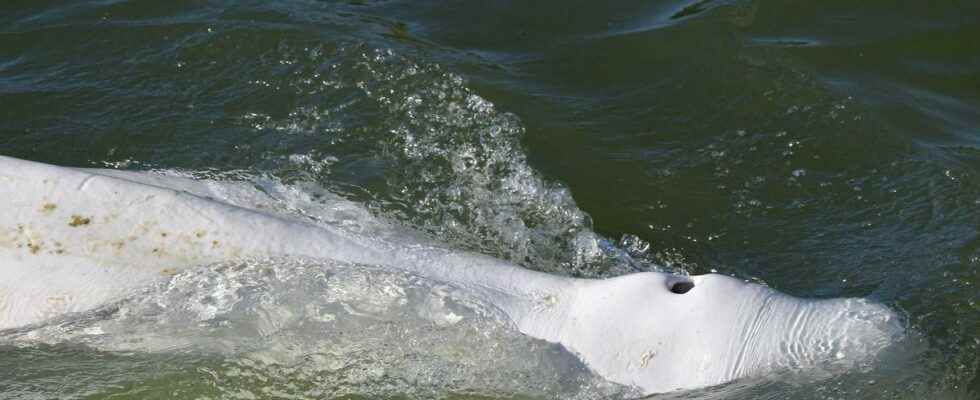REPORTAGE – The extraction operation, which mobilizes dozens of people, began this Tuesday shortly before 10 p.m.
From your special correspondent in Saint-Pierre-la-Garenne Marie-Liévine Michalik, with Soline Roy
“Did you see him then? He’s handsome, isn’t he?” One by one, the fifty firefighters and divers mobilized for an exceptional rescue cross the footbridge which overhangs the Seine in Saint-Pierre-de-la-Garenne, in the Eure, 80 kilometers from Paris. Behind the mild summer, the village lives to the rhythm of the difficult breathing of an unexpected intruder: in these waters a beluga has been surviving for a few days, a cetacean normally living in the Arctic Ocean and in the St. Lawrence estuary. , in Quebec.
Read alsoMarine protected areas: more than 46,000 km² for cetaceans in the Mediterranean
Spotted on August 2 in the river about thirty kilometers downstream, he went up the Seine to this lock 200 meters long, where it was decided to imprison him to give himself time to decide on his fate. . Very weak and sick, having to endure water at 21°C when belugas are used to a polar climate, refusing to feed, the animal has little chance of survival according to Lamya Essemlali, president of the NGO Sea Shepherd Ocean Defense, which is assisting in the animal extraction operation. Others were more optimistic about his fate: Gérard Mauger, vice-president of the Cotentin Cetacean Study Group (Geec), thus described to AFP a “well-toned animal, which spends very little time on the surface and performs long apneas”. This indicates a good lung capacity but does not facilitate the task of the rescuers…
Gigantic net
However, it is out of the question for the firefighters, the prefecture and the associations present to let him die. “After several days of reflection, we decided to launch this operation to extract the beluga whale from this basin to bring it back to the sea”, indicated the sub-prefect of Evreux, Isabelle Dorliat-Pouzet, during a press conference organized on the spot Tuesday afternoon, a few hours before the rescue operation which began in the evening to take advantage of temperatures more lenient. In the meantime, Sea Shepherd launched on the internet a call for ideas to name the lost animal.
The rescue of such a large marine mammal is always complex. It is not possible to put the animal to sleep: cetaceans have conscious breathing, which, under anesthesia, can no longer be spontaneous. The animal therefore had to be caught with a gigantic net, then brought in a barge and placed in a transport box. The beluga had to be suspended there in a large net forming a sort of hammock, with mattresses to prevent it from injuring itself. Then he had to join a truck refrigerated at 18-20°C, the temperature of which must be lowered gradually to adapt him to his new destination: Ouistreham (Calvados), for a short stay in a lock made available by Ports de Normandie . During the trip, “several blood tests and a medical analysis” were on the program, said Isabelle Brasseur, research and conservation manager at Marineland in Antibes (Alpes-Maritimes), asked to participate in this extraordinary operation. “Examinations will continue upon arrival. The spots on his skin will be particularly observed, even if he seems to have scratched for several hours that night, making them disappear.
Read alsoAfter the ban on whaling, the fragile rebirth of this giant of the oceans
Having started at 10 p.m. on Tuesday, the operation promised to be “long and very technical“, added Isabelle Dorliat-Pouzet, mobilizing some 80 people, firefighters, divers, gendarmes, veterinarians and trainers, NGO volunteers. It is not easy to move an animal 4 meters long and 800 kg…” To give you an idea, there will be 24 people to hold the ropes of the net planned to catch the animal, detailed the sub-prefect. ” It is an extremely precise technique that veterinarians and animal caretakers have very finely described, they are experienced people who know how to do it. “Complex, the rescue will not be very expensive: “It will cost us a few thousand euros, and more. We have an incredible chance, it is that this beluga attracts a lot of sympathy. The volunteers are there, the truck lent, the straw that was to garnish it almost offered…
Once the beluga has arrived in Ouistreham, it should spend two or three days in its new pool of seawater, the time to make sure it is better and possibly to perk it up a bit. Then “it will be driven on the high seas, very far from the coast, with the usual means of towing”, explained Isabelle Dorliat-Pouzet. Will he make it? “It is possible that the beluga will die at each stage, but everything had to be tried”,slipped Isabelle Brasseur a few minutes before the operation. men will have done“the maximum and the best possible”.It will be time for the wandering beluga to return to its freedom,“and nature will take back its rights”.
SEE ALSO – Beluga in the Seine: “We’re in a race against time», warns Isabelle Dorliat-Pouzet
